NOTES
Friday, July 6, 2007
morning hours
Birds Sighted in Order of Appearance:
1. mwlblb
2. mlbrg
3. mlbob
4. one banded juvenile (offspring of mwlblb and molbo)
5. morlb
6. mrog chases morlb
7. mplbp
8. unbanded juvenile
9. mwrg (Droopy’s mate)
10. unbanded male (Shopper)
11. mrgw
12. mbow (Bow)
13. mgrr
14. unbanded—rusty bill
Notes:
Pia came this morning and we watched birds for an hour or so, between 10:00 and 11:00. She reminded me the high-pitched cheep, cheep, cheep is a male-only call, heard when other males are around, often accompanied by the wing-flapping display. We watched the babies come and go, pick up bits of leaves, sticks, old peanut shells, not sure yet what food is and isn’t. They resemble baby giraffes in their stance, positioning themselves with their legs splayed at odd angles. I’ve been putting sunflower seeds out with the mixed seed and peanuts each morning. The babies are practicing opening these small nuts and are surprising adept at grasping a sunflower seed with their toes and tap-tapping into the nut. Their bills lack the strength of the adults though, and they are likely to drop the nut before they reach the meat inside. Their breast feathers are beginning to look less gray and more blue. Pia explained that the distinct bands across the tail are an adult feature and aren’t seen until the juvenile’s first molting a year from now. Last year’s juveniles can be identified by their ragged feathers and indistinct tail bands. The shades and hues of blue appear more varied to me in the juveniles—there is a teal-colored grouping of feathers in the wing, in addition to the bright-blue and gray-blue. Their gape is pink, and they look plump and healthy with full breasts. They come with an adult who keeps a lookout perched above them.
Droopy wing came again for several visits—I hope I got a good photo of her. Her mate, mwrg, “Wringer” is a regular male, along with Tame Bird, Red Eye, Mr. Go and Shopper. They continued today in their hierarchical game of chase, Mr. Go still top bird, though compromised because Tame Bird and Red Eye will come so much closer to me and the house; they are both dare-devils in comparison. He is patient though, and will wait for me to leave and re-establish his dominance at this feeder. Today he was busy chasing the newcomer, morlb (Red Eye) who grows bolder by the day.
Rusty bill made an appearance again today. His pink elbows are a sign of leg mites; I learned from Pia. He darts in and out, but I hope to get a photo of him soon. She (Pia) suspects he may be last year’s juvenile, rather than an aged bird, based on the condition of his tail feathers. We will watch and see if this peculiar marking changes after molting.
Finally, I showed Pia photos of mwbw and rrmo molting. She wondered if they weren’t a pair. I didn’t see either of them today. Other birds missing in action include molbo and mprg—both of whom may be sitting on eggs.
Birds Sighted in Order of Appearance:
1. mwlblb
2. mlbrg
3. mlbob
4. one banded juvenile (offspring of mwlblb and molbo)
5. morlb
6. mrog chases morlb
7. mplbp
8. unbanded juvenile
9. mwrg (Droopy’s mate)
10. unbanded male (Shopper)
11. mrgw
12. mbow (Bow)
13. mgrr
14. unbanded—rusty bill
Notes:
Pia came this morning and we watched birds for an hour or so, between 10:00 and 11:00. She reminded me the high-pitched cheep, cheep, cheep is a male-only call, heard when other males are around, often accompanied by the wing-flapping display. We watched the babies come and go, pick up bits of leaves, sticks, old peanut shells, not sure yet what food is and isn’t. They resemble baby giraffes in their stance, positioning themselves with their legs splayed at odd angles. I’ve been putting sunflower seeds out with the mixed seed and peanuts each morning. The babies are practicing opening these small nuts and are surprising adept at grasping a sunflower seed with their toes and tap-tapping into the nut. Their bills lack the strength of the adults though, and they are likely to drop the nut before they reach the meat inside. Their breast feathers are beginning to look less gray and more blue. Pia explained that the distinct bands across the tail are an adult feature and aren’t seen until the juvenile’s first molting a year from now. Last year’s juveniles can be identified by their ragged feathers and indistinct tail bands. The shades and hues of blue appear more varied to me in the juveniles—there is a teal-colored grouping of feathers in the wing, in addition to the bright-blue and gray-blue. Their gape is pink, and they look plump and healthy with full breasts. They come with an adult who keeps a lookout perched above them.
Droopy wing came again for several visits—I hope I got a good photo of her. Her mate, mwrg, “Wringer” is a regular male, along with Tame Bird, Red Eye, Mr. Go and Shopper. They continued today in their hierarchical game of chase, Mr. Go still top bird, though compromised because Tame Bird and Red Eye will come so much closer to me and the house; they are both dare-devils in comparison. He is patient though, and will wait for me to leave and re-establish his dominance at this feeder. Today he was busy chasing the newcomer, morlb (Red Eye) who grows bolder by the day.
Rusty bill made an appearance again today. His pink elbows are a sign of leg mites; I learned from Pia. He darts in and out, but I hope to get a photo of him soon. She (Pia) suspects he may be last year’s juvenile, rather than an aged bird, based on the condition of his tail feathers. We will watch and see if this peculiar marking changes after molting.
Finally, I showed Pia photos of mwbw and rrmo molting. She wondered if they weren’t a pair. I didn’t see either of them today. Other birds missing in action include molbo and mprg—both of whom may be sitting on eggs.
Subscribe to:
Post Comments (Atom)
Pia Sets the Trap

07/24/07
Peaking...

07/24/07
Oops, wrong bird!

Demonstrating the "hold"
Try Again

Bird in the Bag
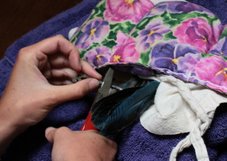
Applying a metal band
Measuring
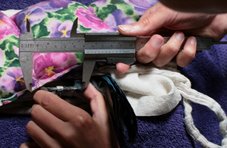
and more measuring. . . .
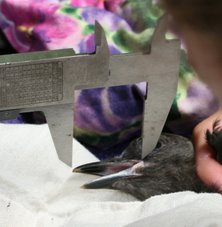
Blood Sampling

Jeff J's Work

Pia's test tube holder
Weighing
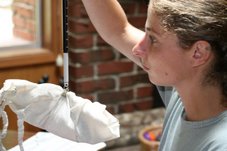
And then....release
When the sun goes down...

Steller's Jay Taxonomy/Description
Common Name: Steller's Jay
Class: Aves
Order: Passeriformes
Family: Corvidae
Genus: Cyanocitta
Species: Cyanocitta stelleri
Steller’s jay belongs to the family, Corvidae, in the Avian Order Passeriformes. Passeriformes is the order of perching birds. Corvidae is the jay, magpie and crow family. The Steller's jay's scientific name is Cyanocitta stelleri. The generic name, cyanocitta, means "blue jay". Its specific name, stelleri, named for George W. Steller (1709-1746). Steller was a German zoologist who explored the coastal areas of the northern Pacific Ocean in 1740.
Band Colors
black | white | purple | red | orangeBands are read in the following order:
light blue and light blue | green
Note: Light blue is difficult to read. It darkens with age, resembling a green band. (b/w/p/r/o/lb/g)
right bottom band
right top band
left bottom band
left top band
Data Collecting
This information was copied from the website of Dr. Jeff Black, Humboldt State University Wildlife Department.
The data to include for each record:
- Bird’s color code
- Size of social group seen at the same time
- Associates’ color codes (or if unbanded = UNB; or not determined = NOTD)
- Number of times associates came within 3 meters of each other
- Approximate time spent within 3 meter distance (e.g. 2 seconds, 15 sec, etc.)
- Total time you watched the birds (e.g. 5 minutes, 10 min, etc.)
- Time of day; start of observation (e.g. 1935)
- Date (e.g. 9.30.99)
- Location of observation (e.g. Rewood Bowl SW corner west bleachers. And state whether the bird was seen at a birdfeeder or in trees, etc)
- Comments (e.g. deformed leg, feather tuft on back, etc.)
Arcata Steller's Jay Sightings
Mr. Go










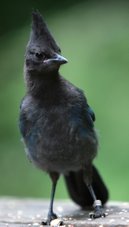










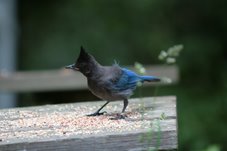











No comments:
Post a Comment